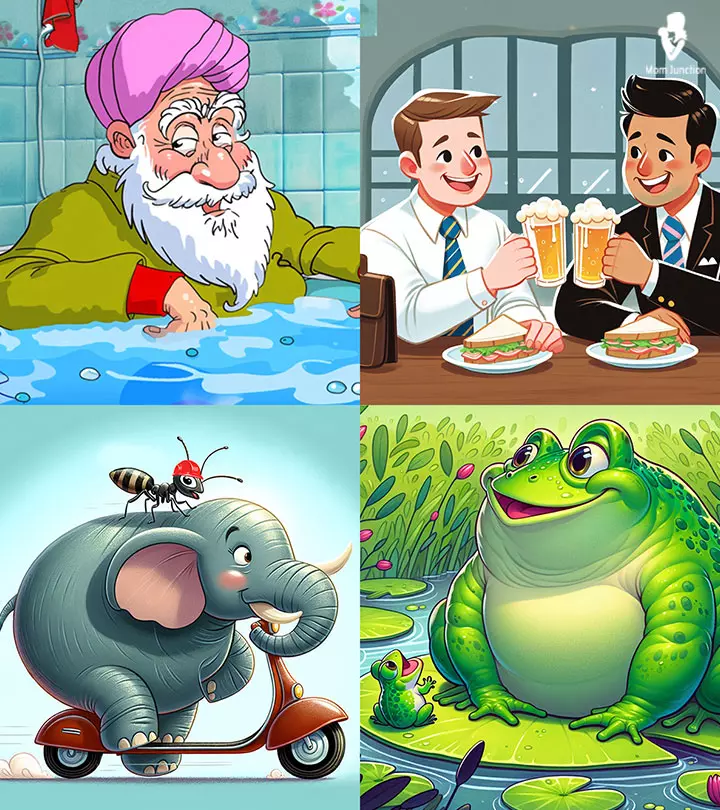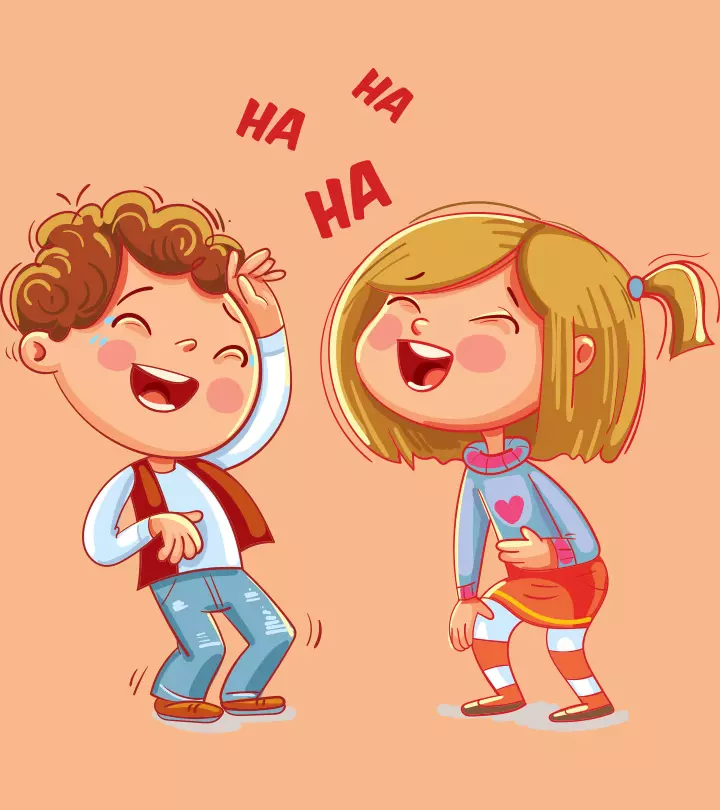
Image: Momjunction Design Team
It is essential for children to know their roots, culture, tradition, and heritage to develop a sense of pride and respect for them. And, Indian mythological stories for kids can be a great way to gain knowledge and learn about ancient times. For instance, the Puranas are a collection of traditional stories that talk about the olden times and how life used to be. Many Indian epics, fables, and legends have tales of heroism and morality. These mythological stories describe the good deeds of the heroes, gods, goddesses, and deities and teach children important values and morals to bring a positive change in their lives. These stories are carried forward through generations with bits from folklore thrown in.

Indian mythology is more than just a collection of stories, it is a crucial educational resource that teaches children important life lessons, values, and cultural heritage. Rich with adventure and moral challenges, these tales encourage critical thinking and guide children in understanding right from wrong, helping them navigate their own lives with greater insight. Moreover, they are interesting and entertaining and help you bond with your children. So, read on to learn more.
Key Pointers
- Telling Indian mythological stories is a great way to teach children about their culture and heritage.
- It is also an interesting way to teach about Indian beliefs and traditions passed through generations.
- These stories are also rich in values and morals, such as kindness, devotion, and truthfulness.
- Telling these stories will also instill spiritual and religious faith and beliefs.
11 Engaging Indian Mythological Stories For Children
1. The valiant Abhimanyu
Abhimanyu was the son of Arjuna and Subhadra. When Subhadra was pregnant with Abhimanyu, Arjuna, one of the five Pandava brothers, decided to tell his wife about the Chakravyuh war techniqueiA multi-layer defensive structure where soldiers are strategically placed to cause maximum damage to the opposing warriors .
Arjuna narrated to Subhadra how to break the Chakravyuh, a labyrinth formed by armed soldiers to trap the enemy, and enter it. Abhimanyu heard and memorized the entire process from inside Subhadra’s womb.
But by the time Arjuna told her about coming out of the Chakravyuh, Subhadra fell asleep. As a result, Abhimanyu learned only entering the labyrinth but couldn’t know how to come out of it. Later in life, when young Abhimanyu fought in the great Kurukṣhetra War of MahabharataiAn ancient epic from India that revolves around two branches of the same family , he had to confront the enemy’s Chakravyuh formation. He could get into the formation, but could not come out.
Abhimanyu took a chariot wheel and swung it around, fighting enemies unarmed. He did not give up easily and fought valiantly till his last breath. Abhimanyu’s courage and determination, even when faced with overwhelming odds, make this story a great lesson for kids.
Moral: Abhimanyu’s tale teaches us to stay determined even when the situation is not in our favor. One must never give up, no matter how tough the going gets.
2. Ekalavya’s allegiance to his teacher
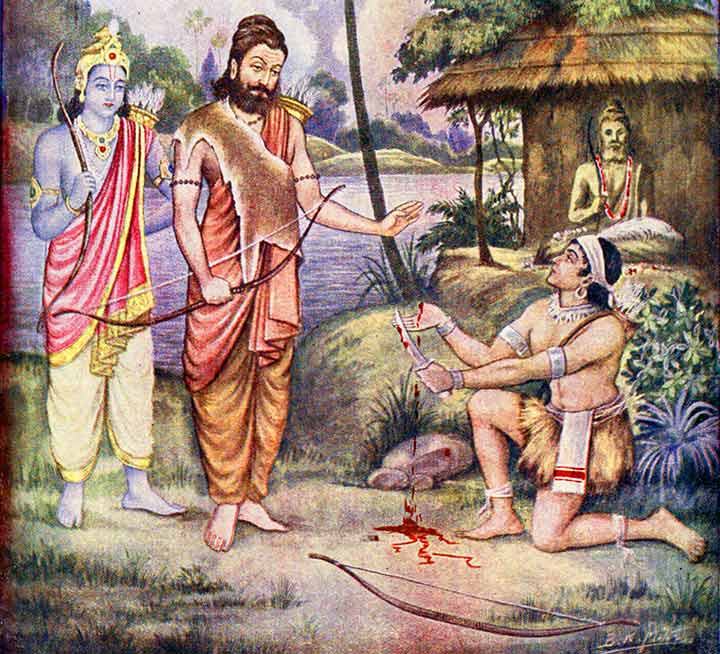
Ekalavya was a young prince of Nishada, a hunter tribe. He wanted to become a great warrior by learning the skills from Dronacharya, the teacher of the Pandavas and the Kauravas. He approached Dronacharya but the latter turned him away as Ekalavya was from a lower caste in the community.
Ekalavya was hurt but did not give up his will to become an archer. He collected the soil on which Dronacharya walked and made an idol out of it. He treated Dronacharya’s idol as the symbolic teacher and perfected himself in archery through several years of practice.
When Dronacharya learned about Ekalavya’s skill, he visited him to know about his Guru. Ekalavya then showed him the idol and said, “You are my Guru.” Dronacharya was worried that Ekalavya would become a better archer than Arjuna, Dronacharya’s favorite student. Therefore, he asked Ekalavya to give his right thumb as Guru Dakshina (teacher’s fee).
Without any questions asked, Ekalavya chopped his thumb and gave it away to Dronacharya thus forfeiting an opportunity to be a better archer than Arjuna.
Moral: This story of Eklavya for kids teaches children about the importance of being focused on one’s goal and respecting teachers.
Moral: This story teaches about being focused on one’s goal, and respecting the teachers.
3. Prahlada’s faith in God
Prahlada was the son of king Hiranyakashipu and queen Kayadhu. Hiranyakashipu believed himself to be the God and there is no other god than him. But Prahlada was a devout follower of Lord Vishnu and continued to pray Him despite getting repeated warnings from his father.
Hiranyakashipu did not like Vishnu because the latter had killed Hiranyaksha, the evil brother of Hiranyakashipu. He scorned Prahlada’s devotion and attempted to kill his son several times, but every time the boy was saved by Lord Vishnu.
One day, Hiranyakashipu challenged Prahlada to show Lord Vishnu, if he really existed. When his son replied that God was everywhere and in everything, Hiranyakashipu showed a pillar and asked Prahlada if Lord Vishnu was there in it. When Prahlada said ‘yes,’ his father got angered and raised his sword to kill him.
Lord Vishnu appeared from the pillar in the form of Narasimha, a half man-half lion, and killed Hiranyakashipu.
Moral: Be faithful to what you believe and don’t get discouraged by naysayers.
 Point to consider
Point to consider4. Shravan Kumar’s devotion to his parents
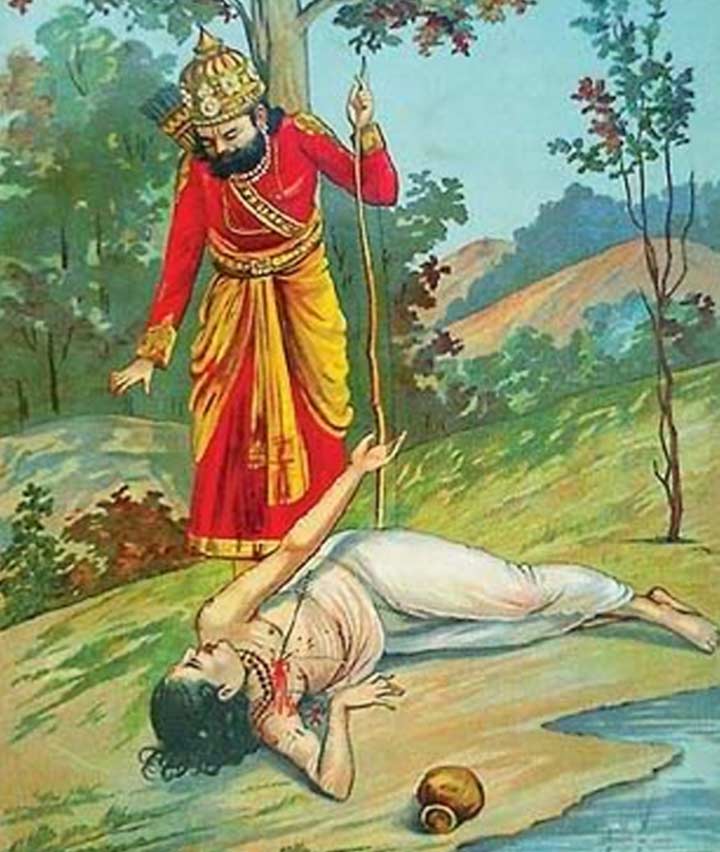
Shravan Kumar, a poor boy, lived with his elderly parents, who were blind. One day, his parents expressed their desire to go on a pilgrimage. But since they were blind, there was no way Shravan could send them alone.
So, he made two large sturdy baskets and tied each basket on either side of a long bamboo stick. He made the parents sit in the two baskets and carried them on his shoulder, traveling to pilgrim places.
One day when they were resting in a forest, Shravan went in search of water for his parents. There, he accidentally got killed by an arrow from King Dasarath’s bow.
Even in his last breath, Shravan asked King Dasarath (Lord Ram’s father) to quench the thirst of his parents and let them know about the tragedy.
Moral: This inspirational story with a moral for kids helps children learn to respect their parents and take care of them when they enter their twilight days.
Stories of young Lord Krishna’s antics have mesmerized many a child growing up. Use this video to tell your child one of the most famous stories from Indian mythology.
5. Arjuna’s concentration
One day, the Pandavas were having a class in archery with Guru Dronacharya. Dronacharya stuck a wooden bird to the tree and asked each Pandava brother to shoot the eye of the bird.
But before they shot the arrow, Dronacharya asked each of them about what they saw. Each Pandava said that they could see the tree, the sky, and the leaves. Dronacharya asked to them shoot the arrow later.
But before they shot the arrow, Dronacharya asked each of them about what they saw. Each Pandava said that they could see the tree, the sky, and the leaves. It was eventually Arjuna’s turn. When Dronacharya asked him what he saw, Arjuna replied that he could see nothing but the eye of the bird, which he had to shoot. Dronacharya was impressed by his reply and asked Arjuna to shoot the arrow, which went straight through the eye of the wooden bird.
Moral: Concentration and complete focus are the key to success.
6. Ganesha and Ved Vyas
Sage Ved Vyas wanted to recite Mahabharata and was looking for a disciple to write the text while he narrated. Ved Vyas approached Lord Ganesha for help, and he agreed to write it.
Ved Vyas had a condition that the story should be written in one go without any pause. Lord Ganesha agreed. However, while writing the Mahabharata, the quill with which Lord Ganesha was writing broke. There was no time to get a new quill as the story had to be written in one sitting.
Lord Ganesha did some quick thinking, broke one of his tusks, and used its sharp end to write the remainder of the story.
Moral: Do not get worried about a problem. Think honestly and you can find a solution.
7. Vibhishana’s devotion
Vibhishana was the younger brother of Ravana, the king of Lanka. He was a part of Ravana’s court and was always surrounded by people who hated Lord Ram and encouraged Ravana in his misdeeds.
Vibhishana warned his brother to give up his evil ways, but Ravana would never listen and instead ridicule Vibhishana for being weak and docile. It never discouraged Vibhishana and he always stuck to the noble path. His righteousness eventually paid off when Ram defeated Ravana and made Vibhishana the king.
Moral: No matter how many detractors you have around you, always stick to the right path.
 Quick tip
Quick tip8. Krishna’s coin
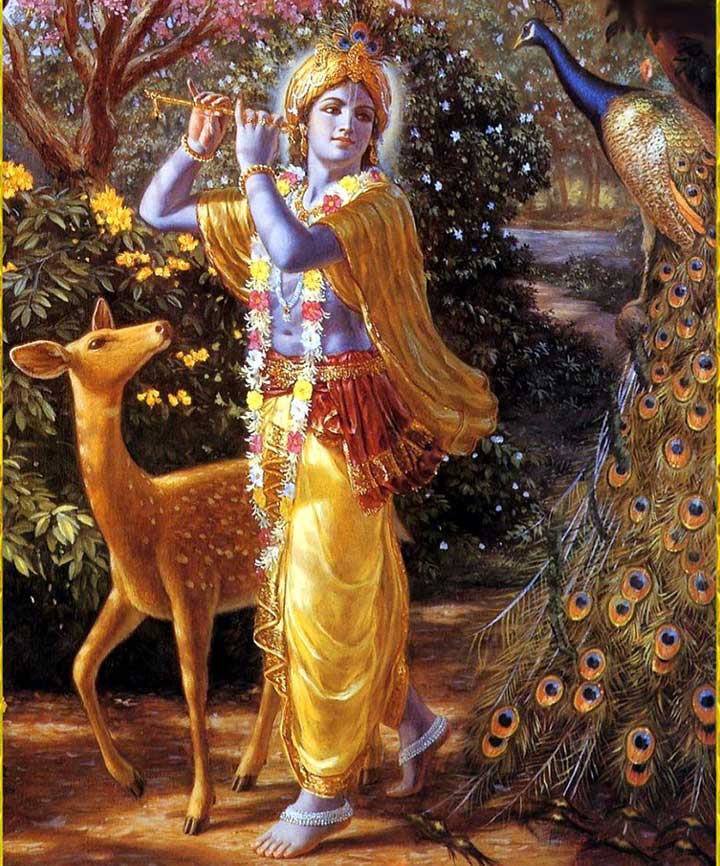
Image: Photo by Virumandi1/CC BY-4.0
One day, when a poor priest was seeking alms, he found a bag of gold coins. As he could not locate the owner of the bag, he decided to keep the bag with himself. On his way back home, he saw a beggar; he pitied him but did not give any coin to him.
As the priest went on his way, he saw a diamond shimmering on the ground. He bent to take the diamond, but a thief jumped from behind, grabbed the bag of gold coins, and ran away. The diamond was just a piece of glass that the thief used to lure the poor man. The priest was disheartened and went back to seeking alms.
Then, Lord Krishna passed by and gave the priest a metal coin. The priest wondered what a single metal coin would fetch him. On his way back home, he saw a fisherman with a couple of fish in his net. The priest felt pity for the fish and bought them with the metal coin. He placed the fish in an earthen pot with water. The next day when he picked the pot to empty the fish in the stream, he was amazed by what he discovered. There were two diamonds in the water.
The fish had accidentally swallowed diamonds when they were in the river and regurgitated them when they were in the pot. This divine intervention had taught him a lesson. The priest burst into tears of joy and thanked Lord Krishna in his mind.
Moral: Help the needy, and the good always comes back to you.
9. Ganesha and Kubera
The lord of wealth Kubera invited Lord Ganesha for dinner. Ganesha attended the event but did not like the Kubera’s flashy nature and ostentatious display of wealth. Ganesha decided to teach Kubera a lesson.
He ate all the preparations made for dinner and demanded Kubera to give him more. Kubera stood in shock as he saw Ganesha devour tons of food. Ganesha’s hunger was insatiable and he threatened Kubera to give more food or he would eat Kubera.
Kubera fled to Lord Shiva in panic. Shiva offered Ganesha a bowl of cereal, which immediately satisfied his hunger. Shiva then turned to Kubera and told him that it was a lesson for him that he must never have false pride as it can come back to bite you.
Moral: Humility is the most precious jewel and much better than any amount of wealth.
10. Bhairavnath and Vaishnodevi
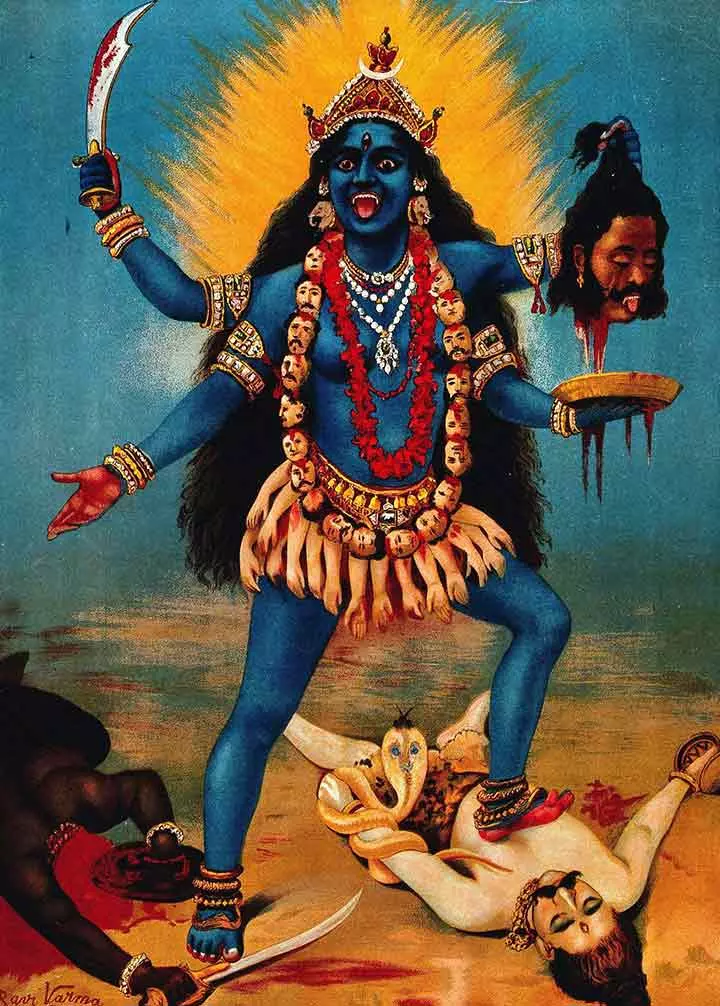
Bhairavnath was a learned sage, who had accumulated so much knowledge that he had become arrogant about it. One day, Goddess Durga was born as VaishnoiIt is a well-known Hindu pilgrimage destination where the goddess Vaishno Devi is worshiped to a couple who lived in the same village as Bhairavnath.
As the little girl was growing up, Bhairavnath observed that she has special skills, and got suspicious of her. He would follow her and observe that she went into a cave every day, and then disappeared.
One day, he located her and followed her to misbehave. This angered Vaishno, who turned into the angry Goddess Kali and killed Bhairavnath with her trident.
Bhairavnath was surprised to see this form of the goddess. With his dying breath, he asked for forgiveness. His honest plea melted the goddess’ heart, and she accepted his apology. Later, she granted him the boon that Vaishnodevi pilgrimage would only be considered complete when pilgrims also visited the Bhairavnath temple to worship him.
Moral: It is never too late to shun one’s ego and transform into a good person.
11. Karna’s generosity
King Karna was known for his generosity. In the Kurukshetra war, when he was lying in the mud dying, Lord Krishna disguised himself as a poor BrahminiHindus of the highest caste who are typically priests and came to Karna to seek alms.
Lying there helpless, Karna couldn’t give the poor Brahmin anything. So, he broke two of his gold teeth and gave them to the disguised Krishna. The Brahmin got furious that Karna gave him the blood-ridden teeth.
Karna pierced the earth with his arrow, brought out a spring of water, washed the teeth with it and gave to Lord Krishna.
Moral: Be generous and help those in need without being selfish.
Frequently Asked Questions
1. What is Indian mythology called?
Indian mythology is called the Vedic mythology. There are four scriptures, Vedas–Ṛig, Yajur, Sama, and Atharva Veda. They remain the principal texts of the ancient Indian civilization.
2. How can I make Indian mythological stories engaging for kids?
Using simple language and visual aids such as books with illustrations can help children engage with the story. Having children roleplay different mythological characters can help them understand the characters better. Breaking longer stories into shorter stories can keep the child engaged and excited. You can also introduce them to mythological videos or apps to develop your child’s interest in mythology.
3. What fun activities or crafts related to Indian mythology that kids can do?
You can let them make masks or even costumes made of paper. For example, they can draw 10 heads for Raavana and attach them to their own head. Moreover, you can arrange drama and skit sessions during festivals, allowing children to participate as various characters. You can also encourage them to make mythological figures out of clay. Children usually like making Ganesha or Hanuman using clay. You also have the option to create puppets for a puppet show. These puppets can be created using materials such as paper, cardboard, socks, cloth, or even plastic.
4. What are some common symbols or motifs in Indian mythology that kids should know about?
Several symbols repeatedly appear in Indian mythological stories. The most common ones are Om, Swastik, Lotus, Snake, Conch, Sun, and Mandala.
5. How has Indian mythology influenced Indian culture and society?
Indian mythology has always had a huge influence on Indian culture. It is the foundation of most of the religions in India. The stories contain gods, goddesses, sages, devas, asuras, royalty, and other concepts that provide moral teaching and guide religious practices. Moreover, mythology greatly influences various arts, music, and festivals. Performing arts often employ mythological stories for their recital. These stories usually denote the victory of good over evil and teach people to remember their values and walk on the path of goodness.
6. Who are some of the most popular characters in Indian mythological stories for kids?
Gods and goddesses like Rama, Krishna, Ganesh, Hanuman, Durga, Lakshmi, Parvati, Brahma, Shiva, and Vishnu are popular subjects in mythological stories for kids. Other characters include sages like Narada, Bhrigu, Agastya, Vishwamitra, Vyasa, and Vasishtha. Stories of the Mahabharata and Ramayana consisting of myriad characters, both human and non-human, are popular among children as well.
7. How do Indian mythological stories compare to other mythologies worldwide?
Indian mythological stories have a variety of complex and diverse characters. These characters are often faced with dharma, karma, and rebirth. However, there is no defining line for their actions. The reader must judge what is right and wrong and incorporate these teachings accordingly. Moreover, Indian mythological stories often mention the concept of cyclic time called yugas. A yuga is a vast amount of time that contains periods of creation, sustenance, and destruction. This is especially distinct from other mythologies, which usually follow a linear time structure.
8. Can I explain the concept of karma as it is portrayed in Indian mythology to children?
The simple definition of karma is that all actions have consequences. As Hindus believe in the concept of rebirth, it is believed that our actions in one life could also have consequences in another life. Hence, good deeds will lead to a good life and vice versa.
9. How can parents incorporate Indian mythological stories into their child’s daily life or routine?
Read mythological stories as a part of your children’s bedtime routine. You can also make them watch movies or shows with mythological characters. Such media are a fun way of introducing your children to Indian mythology and culture. Moreover, explain the importance of each festival and encourage your children to take part in skits or performances depicting these stories. Visit temples regularly and answer their questions patiently. As they grow older, you can discuss the character traits of various characters with them.
10. What are some popular themes in Indian mythology?
Indian mythology features several important themes. Dharma, or duty and righteousness, is a major focus in the Mahabharata with the Pandavas. The theme of good vs. evil is central in the Ramayana, where gods fight against demons. Divine intervention occurs when gods help people during tough times. Finally, many stories offer moral lessons, teaching right and wrong through the experiences of mythological figures.
Brace yourself and learn about the gods of Hinduism! Discover the rich stories, symbols, and meanings of Hindu mythology behind each deity in this comprehensive video.
Community Experiences
Join the conversation and become a part of our nurturing community! Share your stories, experiences, and insights to connect with fellow parents.
Read full bio of Visti Larsen
Read full bio of Harshita Makvana
Read full bio of Deepa Thomas





